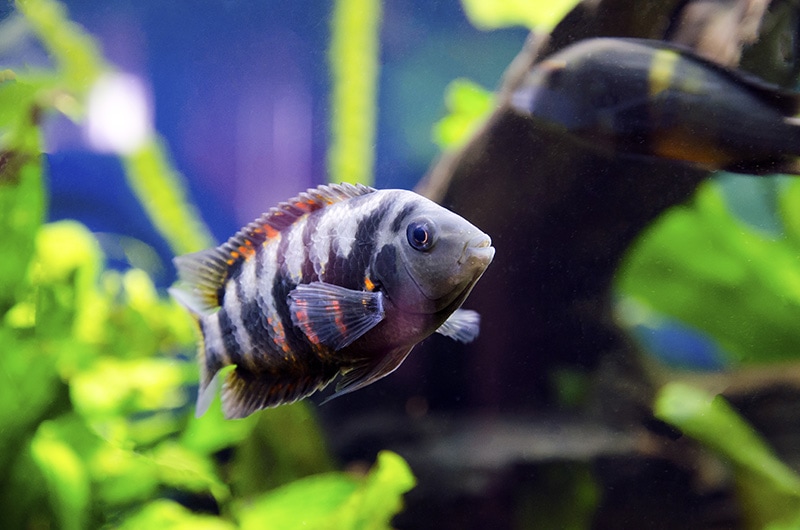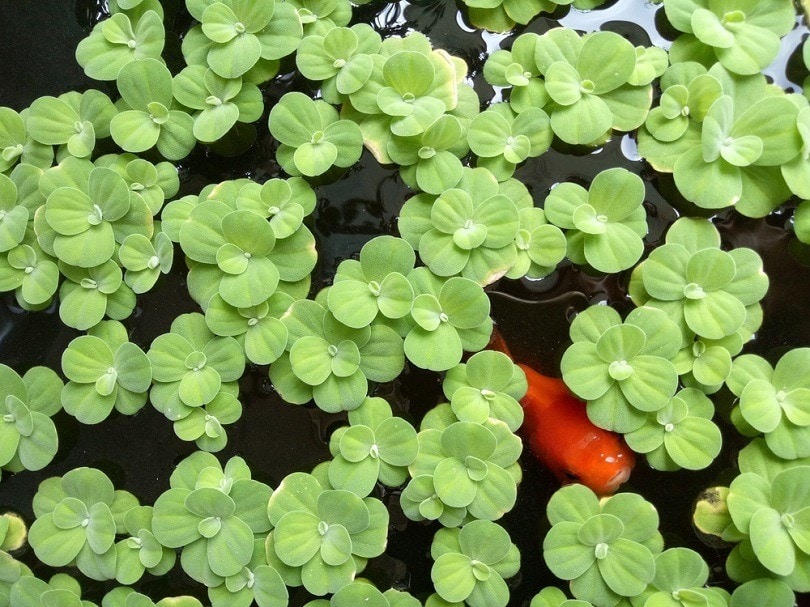How To Stop Cichlid Bullying & Aggression: 10 Vet-Reviewed Tips
Updated on

Click to Skip Ahead
Cichlids are beautiful fish that can be found in dozens of species and varieties to bring life and color to your home aquarium. Unfortunately, these beautiful fish aren’t always the friendliest fish in the bunch. While there are a handful of peaceful cichlid species, most are known for their territorial and bullying behaviors. There are ways you can reduce the risk of bad behaviors occurring in your tank, though.
The 10 Tips on How to Stop Cichlid Bullying & Aggression
1. Add More Fish
- Note: this tip is intended for African cichlids only.
While one of the top things you should avoid in most aquariums is overstocking, cichlids actually tend to do better in slightly overstocked tanks. The more fish that are present in the tank, the smaller each fish’s territory will be. This will reduce the likelihood of large territories developing, which will in turn limit aggression and territorial behaviors. Just make sure that your filtration system provides enough filtration to account for the extra fish in your tank.
2. Rearrange the Tank
Cichlids will develop their territories based on the arrangement of your tank. If you rearrange the décor and plants in your tank, you’ll create a brand-new area for territories to develop, allowing your fish to get on an even playing field again.
It’s also a great idea to perform a water change and rearrange the tank whenever you add new fish. The tank rearrangement will provide an exploration period for your fish. If you add new fish during this time, then your current fish will be more likely to not take as much interest in the newcomers.

3. Remove the Bullied Fish
If you notice one fish in particular being bullied in your tank, then you may need to remove them for a period of time. Moving the fish to a hospital tank or a breeder box within the larger tank will allow the fish to stay safe from their bullies. Oftentimes, smaller fish are more likely to be bullied. However at times smaller fish can become the aggressors as well.
4. Remove the Bully
There are some cases where removing the bullied fish may not fix the problem. Some bullies will simply redirect their aggression toward other fish, while other bullies may indiscriminately bully any fish in their environment. If this is the case, you may need to remove the bully from the environment. Sometimes, a short-term “time out” in a hospital tank or breeder box may suffice, but overly aggressive fish may need to be moved to a new environment entirely.
5. Separate the Water Columns
Aquariums are separated into three main water column levels: upper, middle, and lower. Many cichlids prefer to stay in the middle and lower water columns, but some species like Discus and Angelfish do prefer the middle or upper water column. By choosing fish that live in separate parts of the water column, you’ll prevent overcrowding and overly territorial behavior from all of the fish crowding into one part of the water column.

6. Choose a Long Tank
Aquariums come in a variety of shapes and sizes, and tall, narrow tanks have gained some popularity in the last few years because of their artistic and beautiful appearance. Some fish can happily live in these tall tanks, but cichlids have a distinct preference for lots of horizontal swimming space. By providing your cichlids with a tank that is longer than it is tall, you’ll provide them with more space to move and decrease the risk of aggression. However keep in mind that this largely depends on the species of fish you intend to house in your aquarium. For example, Angelfish and Discus fish need tall tanks because they are naturally tall fish.
7. Mix Species
Some cichlids are more likely to show aggression toward other fish of the same type than other species of fish. Because of this, it can reduce aggression within your tank by mixing a variety of species together. You should also aim to avoid choosing tank mates that are similar in appearance to your aggressive cichlids. Even non-cichlid fish that share similar body shapes and colors may be subject to bullying.
8. Stock Fewer Males
While many species of cichlids can be aggressive in general, males tend to be more aggressive and territorial than females. By stocking larger numbers of females than males and limiting your tank to only a handful of males, you will likely have great success in decreasing the territorial behaviors occurring in your tank. The differences between male and female cichlids vary between species, so make sure to research the specific species in your tank to learn more about identifying males and females. Nonetheless keep in mind that this tip is somewhat anecdotal, as a female who decides to spawn (even in the absence of a male) can become very territorial and aggressive.

9. Provide Plenty of Hiding Places
Hiding places throughout your tank will decrease bullying by providing your fish with places to hide and escape from bullying. Plants and tank décor can be set up in ways to provide escape routes, hiding places, and individual territories for your cichlids. By reorganizing the décor on a semi-regular basis, your fish will have an opportunity to rediscover their environment and develop new territories and tank routes.
10. Feed Them Enough
It may seem obvious, but your fish are likely to be more aggressive if they aren’t getting enough to eat. Most carnivorous and omnivorous fish will resort to eating their tank mates if they aren’t getting enough food.
If you’re already feeding your fish twice per day, then you may need to slightly increase the amount of food you’re giving to them at each feeding. If there is still food left over after a few minutes, then you likely don’t need to increase your feeding. If you’re feeding your fish daily or every other day, then you may need to alter your feeding schedule.

Reasons Cichlids Exhibit Aggression
Territory
Cichlids are particularly territorial fish that are likely to develop territorial behaviors, especially as they get older. They may identify a specific area of the tank as their own space and bully other fish out of their area. While territorial behaviors can be related to defending their breeding territory, some cichlids are simply highly protective of their own space.
Reproduction
It’s not uncommon in the animal world for an animal to defend its ability to breed, and cichlids are no exception. Males may become aggressive when competing with other males for a female. In almost all cichlid species, both females and males also protect the nest full of eggs, which means your fish will exhibit more aggressive and territorial behaviors than usual. Cichlids care for their young, and therefore, a spawning pair will be very aggressive towards other members of their aquarium. This aggression is due to their instinct to protect their offspring from being eaten by the other fish.
Food
Food is a necessary part of survival, and for aquarium fish, they are fully dependent on their owner to get enough food. When food is scarce or not being provided routinely, cichlids may become highly aggressive when competing for food.
Conclusion
Cichlids may often be aggressive and territorial fish, but they can also be excellent additions to certain aquarium environments. Because of their temperament, though, they should be carefully selected, and special considerations may need to be taken in choosing which species of cichlids will be best suited for your aquarium.
You Might Also Be Interested In:
Featured Image Credit: Kraipitch Supyuenyong, Shutterstock













